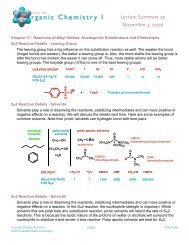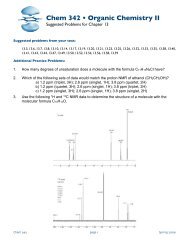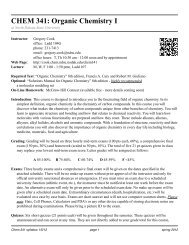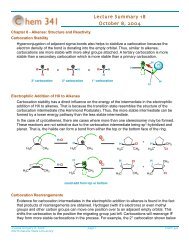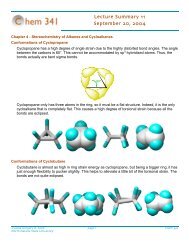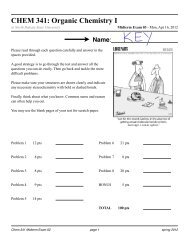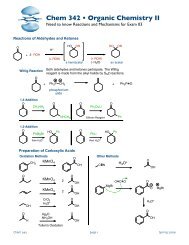REACTIONS AND MECHANISMS For Final Exam - Cook Group
REACTIONS AND MECHANISMS For Final Exam - Cook Group
REACTIONS AND MECHANISMS For Final Exam - Cook Group
You also want an ePaper? Increase the reach of your titles
YUMPU automatically turns print PDFs into web optimized ePapers that Google loves.
<strong>REACTIONS</strong> <strong>AND</strong> <strong>MECHANISMS</strong><strong>For</strong> <strong>Final</strong> <strong>Exam</strong>Reactions for <strong>Final</strong> <strong>Exam</strong>Although you don’t need to know all of the mechanisms for these reactions, knowing themmakes it easier to understand the reactions and to figure out a reaction if you forget it. Consult thelecture notes for more details on the mechanisms.ELECTROPHILIC ADDITION <strong>REACTIONS</strong>HXHg(O 2 CCF 3 ) 2CH 3 OHX+XOCH 3HgO 2 CCF 3NaBH 4OCH 3RHgSO 4OHORRH 3 O + enol ketoneOAlCl 3ClO(note this is really an electrophilic substitution reaction)OO O HCH 3 ClMCPBACH 3 HCH 33 O +OOHepoxideOHBr 2 , H 2 ONaHCH 3OHBrhalohydrinCH1) Hg(OAc) 2 H 2 O CH 3 32) NaBH 4OH© Gregory R. <strong>Cook</strong> page Chem <strong>Exam</strong> Reactions and MechanismsNorth Dakota State University
CH 3BH 3H 2 O 2 , OH - CH 3HOHCH 31) OsO 4 CH 32) NaHSO 3OHOHELECTROPHILIC SUBSTITUTION <strong>REACTIONS</strong>Br 2FeBr 3BrCl 2FeCl 3ClI 2CuI 2IHNO 3H 2 SO 4 NO 2SO 3H 2 SO 4SO 3 HR-ClAlCl 3ROR ClAlCl 3OROBr 2CH 3 CO 2 HOBrO1)Br 2 PBr 3OOH2) H 2 OBrOHNUCLEOPHILIC ADDITION <strong>REACTIONS</strong>ROH1) NaBH 41) LiAlH 42) H 3 O + O2) H 3 O +R OHR HR OHOR OCH 31) LiAlH 41) DIBAH2) H 3 O + O2) H 3 O + OR OHR OCHR H3OR OCH 31) PhMgBr2) H 3 O + OHRPhPhPhOHHCNKOHHO CNPh Hcyanohydrin© Gregory R. <strong>Cook</strong> page Chem <strong>Exam</strong> Reactions and MechanismsNorth Dakota State University
H + or - OHO catalyst+ H 2 OHO OHO+hydrateR-NH 2H + N RimineO+R 2 NHH +RN RenamineOH + RO OR+ 2ROHOan acetalOCH 3 NH 21,4-additionNHCH 3O1) Ph 2 CuLi2) H 3 O + 1,2-additionOPh1,4-additionO1) PhMgBr2) H 3 O + HO PhO1) PhLi2) H 3 O + HO Ph1,2-additionROCl1) PhMgBr2) H 3 O + HO PhRPhOR OCH 31) PhMgBr2) H 3 O + HO PhR PhC N1) CH 3 MgBr2) H 2 OOCH 3© Gregory R. <strong>Cook</strong> page Chem <strong>Exam</strong> Reactions and MechanismsNorth Dakota State University
O+ Ph 3 P CH 2phosphoniumylideCH 2+ Ph 3 P OO 1) NaBH 42) H 3 O + HO H1,2-additionO 1) LiAlH 42) H 3 O + HO H1,2-additionThe addition of hydrides to carbonyls is also considered reductions and more examples are listedunder reduction reactions.MgBrO C OOOMgBrH 3 O +OOHELIMINATION <strong>REACTIONS</strong>H 3 COHH 2 SO 4CH 3E1OHPOBr 3pyridineE2ONH 2ClOS ClC NOBrpyridineOSUBSTITUTION <strong>REACTIONS</strong> (S N 1)CH 3OHHClCH 3OHH-H 2 OCH 3Cl© Gregory R. <strong>Cook</strong> page Chem <strong>Exam</strong> Reactions and MechanismsNorth Dakota State University
CH 3OHClCH 3O H(regioselective like S N1 but stereoselective like S N2)ClCH 3 ClOHSUBSTITUTION <strong>REACTIONS</strong> (S N 2)OHClOSClHOOSCl ClOHBrBrPBrHBrOPBr BrOHClOSTos-ClO TospyridineOH1) NaH2) CH 3 IO CH 3O HI HOIHO+IHO HCl OClOHClO1) PhMgBrOHPh2) H 2 OPhSHCH 3 IPh S CH 3ONaOHOCH 3 IOROHRONaR OCH 3O1) LDA2) CH 3 IOCH 3© Gregory R. <strong>Cook</strong> page Chem <strong>Exam</strong> Reactions and MechanismsNorth Dakota State University
OONaOEt, EtOHOOEtOOEtRBrEtOROEtH 3 COOOEtNaOEtEtOHRBrH 3 COOROEtSUBSTITUTION <strong>REACTIONS</strong> (Nucleophilic Aromatic and Nucleophilic Acyl)ClOHO 2 N NO 2NaOHO 2 N NO 225 °CNO 2NO 2ClHNaOH340 °C2500 psiOHHbenzyneintermediateROOH+ SOCl 2R ClO+ SO 2 + HClROOH+HOORHeatROOOR+ HOHOHAOROHR'OH R OR'ROCl+NaOORROOOR+ NaClROCl+ H 2 OROOH+ HClROCl+ R'OHpyridineROOR'+ Pyridine-HClROClO+ 2 NH 3R NH 2+ NH 4 ClO1) Ph 2 CuLi2) H 3 O +ORClRPh© Gregory R. <strong>Cook</strong> page Chem <strong>Exam</strong> Reactions and MechanismsNorth Dakota State University
OOO+ H 2 O2OOHOOO+ ROHOOR+OOHOOO+ NH 3ONH 2+OOHOR OCH 3+ H 2 ONaOH (cat)ROONa+CH 3 OHHO C NPhHH 3 O + HOOC OHPh HOR NH 2+ H 2 OHA (cat)ROOH+ NH 4 AOCH 3I 2 , NaOHOO+ CHI 3iodoformOXIDATION <strong>REACTIONS</strong>OH CrO 3ORRH 3 O + R ROH CrO 3ORH 3 O + R OHOHPCCORRHO CrO 3ORHH 3 O + R OHOOKMnO 4OHOHO© Gregory R. <strong>Cook</strong> page Chem <strong>Exam</strong> Reactions and MechanismsNorth Dakota State University
KMnO 4OCOHOKMnO 4OCOHOOHKMnO 4 2O1) O 32) Zn, AcOH+HOREDUCTION <strong>REACTIONS</strong> (note - hydride addition to carbonyls is also listed under thenucleohpilic addition section)O1) NaBH 42) H 3 O + R OHRHROHO1) LiAlH 42) H 3 O + R OHRHO1) LiAlH 42) H 3 O + R HR OCH 3O1) DIBAH2) H 3 O + OR OCH 3R CN1) DIBAH2) H 3 O + ORHHOC N1) LiAlH 42) H 3 O +HO NH 2PhHPhHO1) LiAlH 42) H 3 O +ROHROH© Gregory R. <strong>Cook</strong> page Chem <strong>Exam</strong> Reactions and MechanismsNorth Dakota State University
O1) BH 32) H 3 O +ROHROHROCl1) LiAlH 42) H 3 O +ROHO1) LiAlH(Ot-Bu) 3ORCl2) H 3 O + R NH 2RHO1) LiAlH 42) H 2 ORNH2O H 2 N NH 2KOHN NH 2HHa hydrazoneCH 3H 2Pt, 2000 psiCH 3orRh/C, 15 psiOPd/CH 2Pd/CNO 2H 2Pd/CNH 2NO2SnCl 2NH 2H 3 O +© Gregory R. <strong>Cook</strong> page Chem <strong>Exam</strong> Reactions and MechanismsNorth Dakota State University
OTHER <strong>REACTIONS</strong>NBSperoxidesBralso benzylicbromination+EWGEWGCl+KNH 2benzyneintermediateOheatOOHHOheatOOHHO(CH 3 ) 2 CuLiORClR CH 3HO C NPhHH 3 O + HOOC OHPh HOOH 3 O + , HeatOEtOOEtHOR + CO 2RH 3 COOOEtH 3 O + , HeatH 3 COR+ CO 2R© Gregory R. <strong>Cook</strong> page Chem <strong>Exam</strong> Reactions and MechanismsNorth Dakota State University
<strong>MECHANISMS</strong>Electrophilic Aromatic SubstitutionNEED TO KNOW MECHANISMBrBrHBrHBrHBr-HBrBrCarbonyl Addition ReactionsNEED TO KNOW MECHANISMMechanism for Imine <strong>For</strong>mationOHAHOH 2 N RHOH HNRAHOHNRHemiaminalUp to here this isidentical to a hydrationwith amine asnucleophile instead ofwaterHAN RAHNRHNR-H 2 OHHOHNRimineresonance structures© Gregory R. <strong>Cook</strong> page Chem <strong>Exam</strong> Reactions and MechanismsNorth Dakota State University
Acyl Substitution ReactionsMechanism for Enamine <strong>For</strong>mationNEED TO KNOW MECHANISMOHAHOHN RRHOR HNRAHORNRHemiaminalHARN RAHRNRRNR-H 2 OHHORNRenamineresonance structuresThe only difference is this last step. There is noproton on the nitrogen to come off, so a protonis taken off of the alpha carbonMechanism for Acetal <strong>For</strong>mationNEED TO KNOW MECHANISMOHAHOHOHO RHOO H RAHOO RHAHOHO Rresonance structuresHemiacetal-H 2 OROO RARHOO RROHO RO Rresonance structures© Gregory R. <strong>Cook</strong> page Chem <strong>Exam</strong> Reactions and MechanismsNorth Dakota State University
NEED TO KNOW MECHANISMFischer EsterificationOHAOHR'OHHHO OR'AHO OR'ROHROHROHROHHAOAOHHO OR'HO OR'ROR'ROR'RROHHNEED TO KNOW <strong>MECHANISMS</strong>Acid Catalyzed HydrolysisOHAHOHOH 2 OHOHOHAHOO HOCH 3OCH 3OCH 3OCH 3OCH 3HAOAHOHOHOO HOHOHOH- HOCH 3OCH 3HBEST METHODBase Catalyzed Hydrolysis (Saponification)OOCH 3OHOOHOCH 3OOHO+ OCH 3O+ HOCH 3Rapid acidbasereactiontakes placeCarboxylate is a thermodynamicsink and makes the reactionessentiall non-reversible. To getthe carboxylic acid, add acid toprotonate.© Gregory R. <strong>Cook</strong> page Chem <strong>Exam</strong> Reactions and MechanismsNorth Dakota State University
NEED TO KNOW MECHANISMAcid Catalyzed Hydrolysis of AmidesOHAHOHOH 2 OHOHOHAHOO HNH 2NH 2NH 2NH 2NH 2HAOAHOHOHOO HOHOHOHNH 2H© Gregory R. <strong>Cook</strong> page Chem <strong>Exam</strong> Reactions and MechanismsNorth Dakota State University
Other Mechanisms that may be useful but do not need to know.ClO 2 N NO 2NaOHCl OHO 2 N NO 2Cl OHO 2 N NO 2Cl OHO 2 N NO 2NO 2NO 2NO 2NO 2Acid Catalyzed Dehydration - E1 eliminationCH 3OHH + CH 3 HO-H 2 OCH 3HH3° alcohol oxonium is abetter leavinggroup than alcohol3° carbocationbaseCH 3POBr 3 Promoted Dehydration - E2 eliminationOHOPBr Br BrHOOPBrBrNpyridinemild baseOO PBrBr2° alcoholHGood Leaving<strong>Group</strong>pyridineAcid Promoted Substitution - S N 1 - 3° AlcoholsCH 3OHHClCH 3OH-H 2 OCH 3HH3° alcohol oxonium is abetter leavinggroup than alcohol3° carbocationClCH 3Cl© Gregory R. <strong>Cook</strong> page Chem <strong>Exam</strong> Reactions and MechanismsNorth Dakota State University
Electrophile Promoted Substitution - S N 2 - 1° and 2° AlcoholsOHClOSClHOOSClClCl2° alcoholGood Leaving<strong>Group</strong>Inversion ofConfigurationOHBrBrPBrHOBrPBrBrBr2° alcoholGood Leaving<strong>Group</strong>Inversion ofConfigurationOHH +OHHHOS N 2OH-H +OHO Br NaHBrOOBase Catalyzed HydrocyanationHCNbaseOCNOCNHCNHOCNPhHPhHPhHcyanohydrinH 3 O + Ph HHOPhC NHheatHOOCOHHOPhC NH1) LiAlH 4HO NH 22) H 3 O + Ph H© Gregory R. <strong>Cook</strong> page Chem <strong>Exam</strong> Reactions and MechanismsNorth Dakota State University
Wittig ReactionO+ Ph 3 P CH 2phosphoniumylideCH 2+ Ph 3 P Oylides are prepared by S N 2 reactions of phosphines with alkyl halides then deprotonationP+R X Ph 3 P RXHHbasePh 3 PRtriphenylphosphineS N 2triphenylphosphoniumsalttriphenylphosphoniumylideylides are nucleophilic and will react with carbonylsO+Ph 3 PROPPh 3Ph 3POa betaine+PPh 3OAcid ChloridesROOH+ SOCl 2R ClO+ SO 2 + HClClOS ClRO O ClOS ClHClbase (solvent or Cl - )(This step may happen later after kicking off HOSOCl)ROOOS ClORClOO S Cl© Gregory R. <strong>Cook</strong> page Chem <strong>Exam</strong> Reactions and MechanismsNorth Dakota State University
OH + OH Br Br OBr+ HBrOBr 2OBrpyridineOCH 3 CO 2 HO1)Br 2 PBr 3OOHPBr 32) H 2 OBrOHH 2 OOBrH +OHBrBr 2BrOBrOCH 3I 2 , NaOHOO+ CHI 3NaOHiodoformOCH 2I 2OCH2IrepeatOCIIINaOHO OHC II I© Gregory R. <strong>Cook</strong> page Chem <strong>Exam</strong> Reactions and MechanismsNorth Dakota State University



